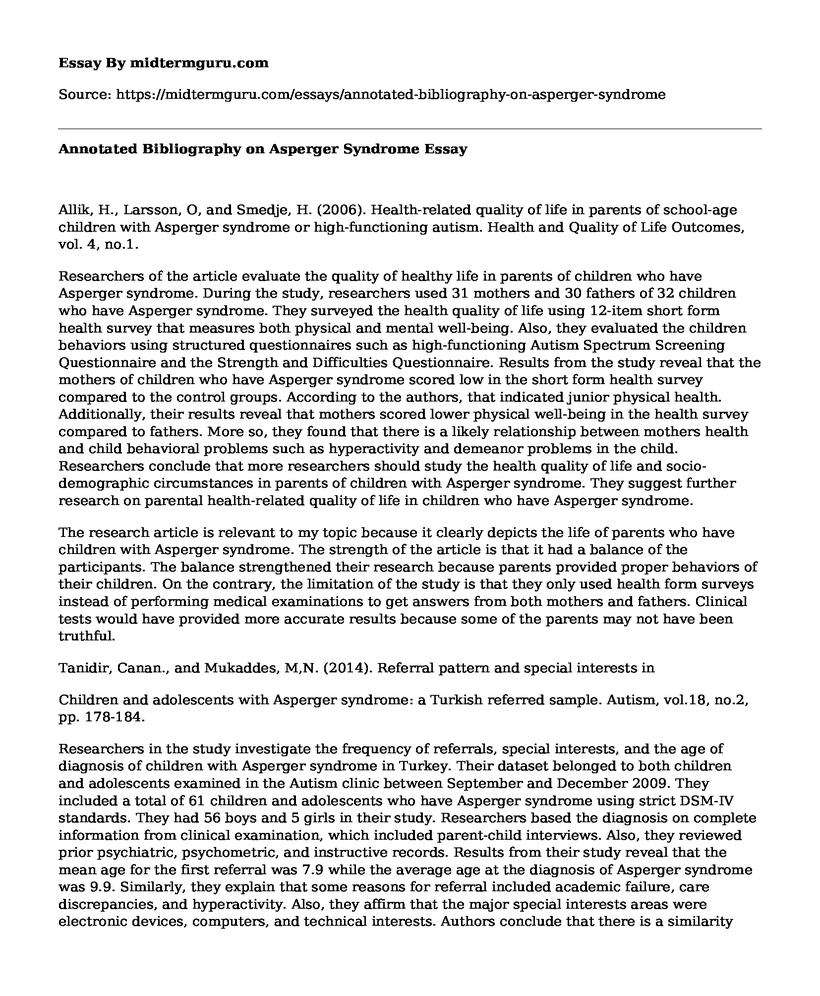Allik, H., Larsson, O, and Smedje, H. (2006). Health-related quality of life in parents of school-age children with Asperger syndrome or high-functioning autism. Health and Quality of Life Outcomes, vol. 4, no.1.
Researchers of the article evaluate the quality of healthy life in parents of children who have Asperger syndrome. During the study, researchers used 31 mothers and 30 fathers of 32 children who have Asperger syndrome. They surveyed the health quality of life using 12-item short form health survey that measures both physical and mental well-being. Also, they evaluated the children behaviors using structured questionnaires such as high-functioning Autism Spectrum Screening Questionnaire and the Strength and Difficulties Questionnaire. Results from the study reveal that the mothers of children who have Asperger syndrome scored low in the short form health survey compared to the control groups. According to the authors, that indicated junior physical health. Additionally, their results reveal that mothers scored lower physical well-being in the health survey compared to fathers. More so, they found that there is a likely relationship between mothers health and child behavioral problems such as hyperactivity and demeanor problems in the child. Researchers conclude that more researchers should study the health quality of life and socio-demographic circumstances in parents of children with Asperger syndrome. They suggest further research on parental health-related quality of life in children who have Asperger syndrome.
The research article is relevant to my topic because it clearly depicts the life of parents who have children with Asperger syndrome. The strength of the article is that it had a balance of the participants. The balance strengthened their research because parents provided proper behaviors of their children. On the contrary, the limitation of the study is that they only used health form surveys instead of performing medical examinations to get answers from both mothers and fathers. Clinical tests would have provided more accurate results because some of the parents may not have been truthful.
Tanidir, Canan., and Mukaddes, M,N. (2014). Referral pattern and special interests in
Children and adolescents with Asperger syndrome: a Turkish referred sample. Autism, vol.18, no.2, pp. 178-184.
Researchers in the study investigate the frequency of referrals, special interests, and the age of diagnosis of children with Asperger syndrome in Turkey. Their dataset belonged to both children and adolescents examined in the Autism clinic between September and December 2009. They included a total of 61 children and adolescents who have Asperger syndrome using strict DSM-IV standards. They had 56 boys and 5 girls in their study. Researchers based the diagnosis on complete information from clinical examination, which included parent-child interviews. Also, they reviewed prior psychiatric, psychometric, and instructive records. Results from their study reveal that the mean age for the first referral was 7.9 while the average age at the diagnosis of Asperger syndrome was 9.9. Similarly, they explain that some reasons for referral included academic failure, care discrepancies, and hyperactivity. Also, they affirm that the major special interests areas were electronic devices, computers, and technical interests. Authors conclude that there is a similarity between the type of special interests and the reasons for referral in the Asperger syndrome sample with the interest areas and the grounds for referral of people with Asperger syndrome from developed countries.
The research is relevant to my topic in a manner that it provides informative information on the referral patterns as well as the special interests in children from Turkey and developed western countries. The strength of the article is that it appears plausible because it involved extensive clinical examinations and interviews with both the parents and their children. On the other hand, the limitation of the research article is that it was gender bias. Researchers included only 5 girls compared to the 56 boys in their study. They would have created a balance between males and females who participated in the study to come up with accurate results.
References
Allik, H., Larsson, O, and Smedje, H. (2006). Health-related quality of life in parents of
school-age children with Asperger syndrome or high-functioning autism. Health and Quality of Life Outcomes, vol. 4, no.1. Retrieved from http://hqlo.biomedcentral.com/articles/10.1186/1477-7525-4-1
Tanidir, Canan., and Mukaddes, M,N. (2014). Referral pattern and special interests in
Children and adolescents with Asperger syndrome: a Turkish referred sample. Autism, vol.18, no.2, pp. 178-184. http://journals.sagepub.com/doi/pdf/10.1177/1362361312457716
Cite this page
Annotated Bibliography on Asperger Syndrome. (2021, Jun 01). Retrieved from https://midtermguru.com/essays/annotated-bibliography-on-asperger-syndrome
If you are the original author of this essay and no longer wish to have it published on the midtermguru.com website, please click below to request its removal:
- Annotated Bibliography on Obsessive Compulsive Personality Disorder - Psychology Paper Example
- Assignment Example on Mental Health Assessment: Acute Confusion (Delirium)
- Paper Example on Strategic Family Therapy
- Depression in College Students: Annotated Bibliography
- Critical Essay on The Global Grapevine: Why Rumors of Terrorism, Immigration, and Trade Matter
- Mental Illness: Causes, Types & Effects - Essay Sample
- Stress in Our Lives: How to Manage and Maintain a Healthy Lifestyle - Essay Sample







